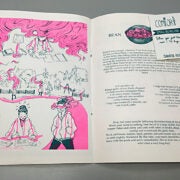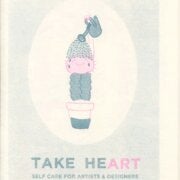Staying true to the ethos of zines at OCAD U
Editor’s note: this post was originally published in May 2017 and has been updated to reflect Artstor’s platform changes.
- Intl zine day collage zine by OCAD Zine Collective
We invited Marta Chudolinska, Learning Zone Librarian at the Ontario College of Art and Design University, to tell us about the collection of zines they are making openly available via Artstor’s public collections. You can view the collection in Artstor here.
The OCAD U Zine Library is an ever-growing collection of self-published and handmade objects located in the Learning Zone at OCAD University. The Library contains an incredible range of zines (pronounced “zeen,” as in magazine), in terms of subject matter and form. Zines are a very flexible medium – they can be about anything that the creator wishes, often incredibly personal, political, or conceptual, and production can range from the cheapest, easiest options, such as photocopiers, to finely crafted, handmade approaches such as screen printing or letterpress.
The collection was started by former student Alicia Nauta in November of 2007 with hopes to inspire, educate and entertain, to encourage collaboration between OCAD U students and to open up the world of zines for readers and creators everywhere. When Alicia graduated, maintenance and development of the collection were continued by OCAD University Library staff. In 2009-2010, reference interns Laine Gabel and Marta Chudolinska devised a unique cataloging system based on best practices identified from other zine libraries and zine communities, which was later expanded to meet zine library cataloging standards as established by zine librarians across Canada and the US as xZINECOREx.
Our zines are catalogued and arranged into 13 categories: art, comics, fashion, info/DIY, music, OCADU (for zines made by OCAD U classes, departments, and student groups), perzines (a genre of zines written like diaries or journals, often sharing vulnerable writing related to mental health and other personal challenges), photography, poetry, politics, queer, sex & sexuality, and stories. Many of the zines in our collection come from our student community, and since we are an Art & Design institution, our art and comics categories have the most content.
- Take Heart zine featuring work by Leanna Bleakney and Olivia Kim and mini zine insert by Jennifer Fryer. Photo by Heather Evelyn
- Take Heart, Self Care for Artists and Designers by OCAD Zine Collective, Design by Jon Vannesse. photo by Heather Evelyn
Some of the zines in our collection straddle the line between zines and artist books or zines and artist multiples. At present, we do not censor or edit items that have been donated to our collection, unless the item can be classified as hate speech. In our collections development, we endeavor to purchase zines that expand and enrich the underrepresented areas of the collection that we may not generate through donations, particularly zines from queer communities, and those made by Black, Indigenous, and other persons of color.
In general, the zines in our collection tend to be contemporary as opposed to historical, with a large majority of the zines in our collection being created from the year 2000 to present. One historically significant part of our collection is a partial run of Factsheet Five. Factsheet Five was an independent American magazine about zines published from 1982 to 1998. It was the place to learn about zines, read reviews of zines, and find out how to order them from creators and distros (a person or group who distributes zines and other independent publications at zine fairs or online) long before the internet was in common usage. Broken Pencil magazine, a contemporary Canadian magazine about zine culture and independent arts, is also featured in our collection and continues the legacy of promoting and celebrating zines started by Factsheet Five.
Our collection provides many excellent opportunities for outreach and community building. Faculty and students engage with the collection through class visits and assignments made in response to the collection. We even have class visits from outside institutions, such as high school classes from our local school board and comics or publishing classes from other local colleges. A common assignment used to engage with the collection is for students to select a zine from the collection and write a review of it, looking to issues of the Factsheet Five and Broken Pencil in our collection to see examples of zine reviews. One class even collected the reviews into a zine, which they then donated to our collection. Meta! Another frequently encountered assignment is for students to make their own zine after handling dozens of zines from our collection to see the vast range of approaches possible. They are usually tasked with making an additional copy of the zine to be added to our collection. We have had various visits over the years from researchers interested in zines and from the staff of other libraries who are embarking on starting their own zine collections.
The Learning Zone staff help to lead a student group called the OCAD U Zine Collective, which provides an opportunity for members to learn about zine culture, share their work, develop skills, and collaborate on publications and other projects. The collaborative zine making that we engage in during group meetings (choosing a theme, making pages, and assembling the zine all in one day) gives students who are just starting to get involved with zines the opportunity to be part of creating a publication, without the stress and pressure of doing all of the work themselves. This immediacy of production inspires them and propels them to make work of their own.
In 2014, we created a zine called Ghost Stories, which collected images, poems, and legends about the ghosts that purportedly haunt OCAD University, with submissions open to the entire OCAD U community. The intention of this publication was to have some fun and to bring together stories and lore that point to the long history of our institution. In 2015-2016, we produced a zine about self-care called Take Heart: Self Care for Artists and Designers, which we printed on the risograph, a machine that can best be described as a marriage between photocopying and screen printing, in the University’s Printmaking department. Again, submissions were open to the whole OCAD U community, not just the group, and the theme resonated deeply with our community, based on the number and quality of contributions submitted. The intention of this publication was to collect and share information and tips about taking care of your physical, mental and emotional well-being as a creative person, as well as to commiserate about the challenges involved in doing so. In the past year, we have produced a range of one-session collaborative zines, and are currently collecting submissions for a zine on the theme of fandom that, again, will be designed by the students and printed on the risograph.
In addition to class visits and the work of the Zine Collective, the Zine library also organizes the annual OCAD U Zine Fair and a series of Zine Workshops. The Zine Fair is an opportunity for our collective members and other students and local zinemakers to sell their zines and connect with each other. In lieu of charging a vendor fee, we ask that everyone with a table donate at least one item to the Zine Library, thereby enriching our collection and preserving the work produced by students at the University. The Zine workshop series, open to all students and supported by Ontario government funding through the First Generation program, helps students develop skills in bookbinding, linocut printing, screen printing, and other techniques that broaden their abilities to make zines.
- Printmaker Resource Zine made by Printmaking Professional Practice class with Professor Anthea Black
Since 2010, I have been searching for a way to make the zine catalog searchable to the OCAD U community and the general public. Making the catalog openly available to the general public was one of the primary goals in selecting the best search tool for the collection, since so much of the content in the collection was donated by the general public. Additionally, locking the catalog behind a user login went against the ethos of zines and zine culture: to be open, accessible, and existing outside of the regular boundaries of institutions. When our Visual Resources Department selected Artstor’s Shared Shelf as the primary tool for our institutional image database, the Learning Zone staff immediately saw the benefits of using this system, particularly the ability to publish publicly on Shared Shelf Commons, for sharing the catalog of the collection.
The OCAD U Library’s Visual Resources department has been instrumental in making this project a reality. Since 2011, long before we had a system selected, they have been scanning the covers of zines in our collection in preparation for the time that the catalog would go live. At present, we have almost 2200 zines cataloged, so this has been no small feat. In the past year, they have worked with the Learning Zone staff in editing and expanding our cataloging metadata to map onto Shared Shelf standards, as well as providing us with hands-on training in using the administrator functions and cataloging back end of the system.
We are incredibly pleased and proud to have the collection accessible, searchable and visible through the images of the zine covers. We hope that by having the collection available on Shared Shelf Commons, we will see an increase of access and use by the OCAD U community, outside researchers and the general public. The Zine Collection is constantly growing. We have hundreds of new zines to catalog and add to Shared Shelf Commons. We continue to collect zines through donation and purchase. We have an ongoing collaboration with Broken Pencil magazine, whose staff donate review copies of zines sent to them to our collection after they have been reviewed. These collection development practices, as well as the ongoing and enduring excitement about zines at OCAD U, in Toronto and beyond, means that there is no end in sight for the development and expansion of our special collection.

Creature Feature by OCAD Zine Collective
You might also be interested in Sticky art: the Street Art Graphics collection



